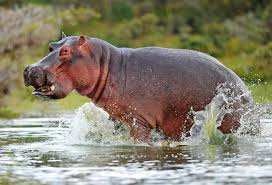Cocaine Hippos - How They May Be Helping the Ecosystem by Colin Kowalski
Pablo Escobar - a man who is known for his notorious drug cartel - may actually have brought some good to the world. Well, not exactly him, but nearly 80 hippos descended from the four hippos that he used to own. When those four hippos were released into the wild, they reproduced and created the 80 hippos today know as the "Cocaine Hippos." Upon initial release, these hippos were hypothesized to bring harm to the local ecosystem, due to their invasive nature, but new studies might be revealing the only possible positive aspect of Escobar's legacy.According to Live Science Magazine and other sources, Cocaine Hippos have recently been thriving in the local Columbian Ecosystem. However, they haven't been the only thing thriving, rather, the entire ecosystem is seeing the benefits of these hippos. Initially, they were thought to be an invasive species, being a foreign species brought with no natural predators, and it was hypothesized that they would wreak havoc in Columbia. However, scientists are seeing quite the contrary. These hippos are revitalizing a once struggling ecosystem. This anomaly traces its roots to the Paleolithic Era - when stone tools were first developed. This era, also known as the Pleistocene Epoch, was much colder and was defined by the last Ice Age. Due to the cold temperatures reaching as far as the equator (where Columbia is located), the animals there were equipped for the cold temperatures. However, as the temperature increased, the Pleistocene Epoch waned, and the Holocene Epoch dawned, large herbivores began to go extinct. Although the exact reasons are unknown, most geologists believe that this mass extinction at the end of the Pleistocene Epoch was due to both the change in the climate and the overhunting of the large herbivores. Without these herbivores, some of which are known as the Giant Llama (Hemiaucheina paradoxa) or the semiaquatic beast Trigonodops lopesi, major nutrients weren't being produced and released by their feces, leading to the slow deterioration of the soil.

However, now with the Cocaine Hippos present, these nutrients are returning to the ecosystem, greatly helping all levels of the food web there. Due to the immense similarity between hippos and the extinct herbivores, especially the Trigonodops lopesi, the hippos have executed similar roles as these animals, helping to fill a gaping hole left by these extinct creatures. So, thanks to these Cocaine Hippos left by Pablo Escobar, the Columbian ecosystem is on the rise.
Above is one of Pablo Escobar's famed "Cocaine Hippos"


So interesting!
ReplyDelete